Most of us spend a significant amount of time in our cars, whether it’s commuting or running errands or simply enjoying the road. But many of us don’t know the basics of vehicle maintenance or repair. With a little do-it-yourself spirit and a few basic tips, you can learn how to do most anything on a car.
First, find the owner’s manual for your vehicle. This is a high level guide to most of the major components, complete with troubleshooting suggestions for your particular make and model.
How To Jump Start A Vehicle
Keep the following in your car at all times:
- Jumper Cables: The longer, the better!
- Mechanic Gloves: Disposable gloves at the very least, but heavy duty offers more protection
- A Flashlight: Always handy to keep in your car!
- Paper Coveralls: Protection for your clothes – paint stores usually carry these
- Owner’s Manual: You can often find this in your car’s glovebox
To jump start your car, you will need to find someone with a vehicle to provide the jump to your dead battery. It is important to be safe and use sound judgment when seeking assistance from people you don’t know. Don’t accept help from anyone you don’t feel comfortable around, and be sure to phone a loved one to let them know exactly where you are and what’s going on.
Before you and your helper begin the jump-start process, here are a few words of caution:
- Read your owner’s manual, first. Your manufacturer may advise against jump starting a vehicle due to sensitive electronic circuitry.
- Don’t try to jump a frozen battery.
- Do NOT jump a battery that is cracked or leaking. This is very dangerous. You will need to purchase a new battery at this point, so call a tow truck or a friend that can help you out.
- Ensure that the battery isn’t dry. Check individual cells for fluid levels and add water accordingly. Check your owner’s manual for details and warnings.
- If there is corrosion (white or greenish powdery stuff) on the battery, try to clean it off with a wire brush, aluminum foil or anything but your hand as the chemicals can be damaging to your skin. Be sure you cover your nose and mouth to avoid inhaling the dust as it is a lung irritant.
- Once you begin the process of hooking the cables up NEVER allow any of the hook-up clamps to touch. Each person should hold an end of the cables and keep the two clips separate (one to each hand is a good idea).
Step-by-step Guide:
- Start by protecting your clothes and your hands with protective clothing or a blanket on the ground and gloves.
- Open the hood to your car. Sometimes when you “pop” the hood, you need to also release the latch. This can be found by running your fingers under the slightly open hood until you find a little lever to push on. Use the stick to prop the hood open while you work.
- Locate the battery. If you aren’t sure where to find the battery, your owner’s manual should provide instructions or a picture to guide you.
- Ensure that the donor car is parked close to yours and that it is turned off before you start.
- On the battery there are two post “terminals”. One is positive (+), usually red and one is negative (-), usually black.
- The positive terminal post (+ or red) should have a plastic cover that opens easily to expose the metal beneath. Keep in mind that when you begin to attach the cables to each component, you want it to be as solid as possible to ensure a safe and complete connection.
- Take a POSITIVE (red) clamp and attach it to the dead car’s positive terminal post (+ or red). The clamps should have metal teeth that help them grip the terminal post.
- Take the POSITIVE (red) clamp at the opposite end of the cables and attach it to the positive terminal post (+ or red) of the good, working battery. Their car should still be off!
- Next, take the NEGATIVE (black) clamp on that end and attach to the (-) terminal of the good, working battery.
- Take the final NEGATIVE (black) clamp and attach it to a non-painted metal surface on the main engine block of the car that is being jump-started (yours). A good metal surface could be a metal nut or bolt and farther away from the battery is better to allow for solid grounding.
- At this point, once all of the connections have been secured, start the donor car. After a few minutes, try to start your car. If your car won’t start, then wait several more minutes and try again.
- If this doesn’t work, stop. Working in reverse order, unhook each of the clamps and thank the owner of the donor car. It’s time to call for professional help.
- When the dead car is started, check the battery light on the instrument panel. If it is on, this may mean that the alternator is not charging the battery and the driver should not run the vehicle very long. If this is the case, call for professional help.
- If your car does start, let it run for a few minutes to help charge the battery further.
- Unhook the clamps in the reverse order of how you put them on. Be sure to drive your car for about 30 minutes before stopping again so the battery can continue to charge. Otherwise, you might need another jump start.
For the true do-it-yourselfer, look into a Jump Start Box or Jump n’ Carry. These small boxes run about $150, but they can provide you with a solo jump start regardless of where you are. Be sure to read the details and your owners manual to ensure this is an option for your vehicle.
Print this article out and keep in your glove compartment for easy reference.
A dead battery is just one of the things GEICO’s Emergency Roadside Service can help you with if you get stranded. Add it to your auto insurance policy today for just pennies a day per vehicle.
Next article: How to Check Tire Pressure

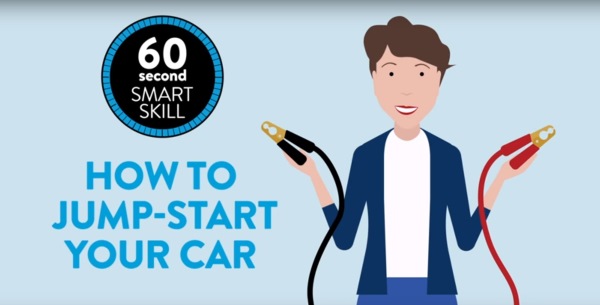


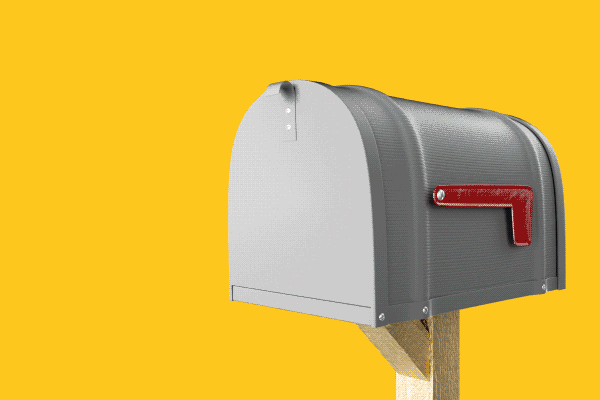


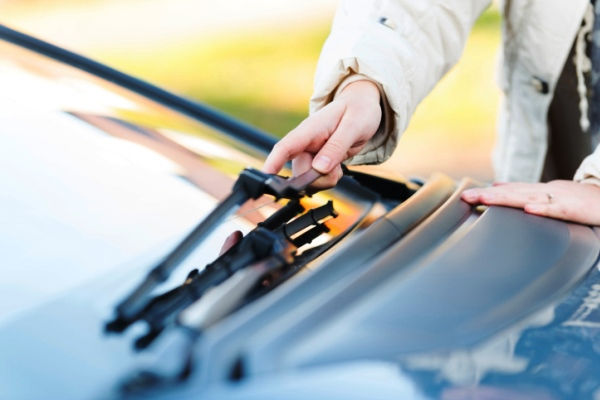
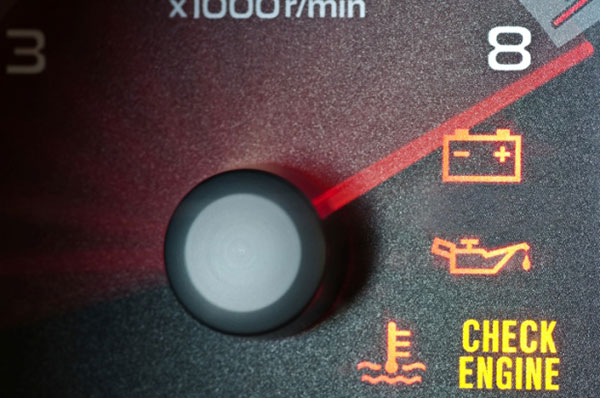
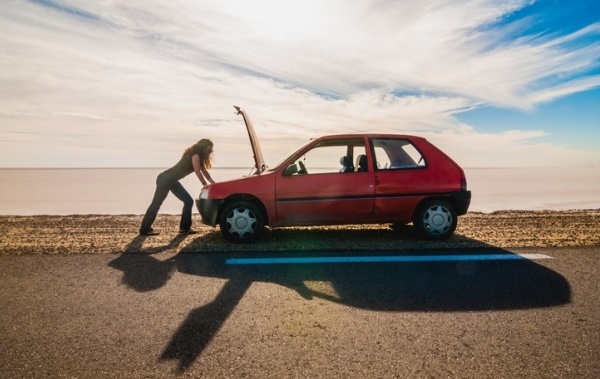
Katherine says,
Thank you for the video! I’ve never had to do that but worried I wouldn’t know how.
Bernard Berridge says,
To prevent arcing, the ground terminals should be connected first. Around an engine ,there is always the possibility of fuel vapors.
vincent santiago says,
Well, yes , it’s very useful information. Everyone should know how to use jumper cables. Specially woman. I’d done it to people that have asked me for help.
Janet says,
I thought the black clamp should go on the negative terminal of the dead battery– no? This says something different in # 10.
vincent santiago says,
Well, Janet got confused a little bit here. Thats because the black clamp of the terminal cable to the dead battery is been instructed to ground on any metal or screw away from the battery. Well, Janet , you can still connect the black clamp on the negative of the dead battery , but it’s safer on a metal section away from the battery.
Bill says,
No. Never to the terminal.
Antoine Caldwell says,
Please explain how to jump start a hybrid .
Or is there never a need to?
Rick Gillespie says,
“At this point, once all of the connections have been secured, start the donor car. After a few minutes, try to start your car. If your car won’t start, then wait several more minutes and try again.”
The donor car should never start their car. Starting their car allows it to become part of the others electrical system. Not a good idea. The donors car battery should be enought to start the other car. If not , too many other issues to be safe for the donor’s electrical system.
Judith Light says,
Why would it not be okay to use a portable jump starter on a vehicle?
You say to check the owner’s manual and mine tells me how to jump start from a battery (either in another vehicle or not in another vehicle). Is a portable jump starter different from a battery?
I’m referring to this sentence in the last paragraph, “Be sure to read the details and your owners manual to ensure this is an option for your vehicle.”
Peter says,
Judith, it’s OK to use a portable jumpstarter, it’s actually the preferred solution, but most of us don’t have one handy when we need it. Therefore, we use our own car battery in lieu of a jumpstarting battery, to help someone else to start their car.
Tim Donk says,
Are you kidding me with all this? Most notably the gloves and coveralls.
Marni says,
We just jump-started a car. Is it ok to let it idle for the 30 minutes instead of driving it around?
Thanks!
Judith Light says,
I’m not an expert but I think it is not okay to let it idle. I’ve read that the engine has to be at 2000 rpms or higher for significant charging to occur.
Pericles says,
Superb! Thanks.
Carrie says,
, Thank Goodness. I needed information on how to do this. ☺
Doug Haughton says,
The “symptoms” description mentions using a wire brush to clean corroded terminals. First, a wire brush is a dangerous way to clean “live” electrical connectors. Second, you are only able to remove surface corrosion with this method. Third, corrosion is always an indicator of a problem in the charging/ battery system.
When making the last of 4 connections in the jumper cable hookup, you should always attach to the “good” car, not the “dead” car. The reason for this change to the above outline is simple and much safer…..the last connection will result in a spark due to the disparity in battery voltage. You never want this spark to occur in the vicinity of a discharged battery. The spark WILL occur, and should be as far away from the discharged battery as possible. The last connection (as outlined) should be the black (negative) cable, and attached to the good car’s engine block or other large metal in the engine bay, never to the battery, and never to the “dead” car.
Valerie says,
the first time I needed a jump thank goodness I found someone nice enough to have jumper cables from now on I will be backing into a parking spot because I had to find whoever was in the store and ask them to move the car
Thomas S. Johnson says,
You’d mentioned to make sure the water in the battery is at it proper level, but I never saw which should be incerted is the word “distilled
water”! Is what you should be put in your vehicles battery!
Jon says,
Hi Thomas, you should not come across this issue as almost all batteries come sealed now. 30+ years ago you had to add water.
Marcialito Sacoma says,
VERY INTERESTING. NOW I KNOW HOW TO JUMP START.
Tim says,
This will not work on trucks with diesel engine s as they have 2 battery s. Let people know how to fo this without damaging the wireing in the truck.
Jon says,
You shouldnt drive a diesel unless you have some bare minimum knowledge of how to maintain it… that should go with your driving test on any vehicle, then we wouldnt have so many clueless people stuck on the roadway when shtf